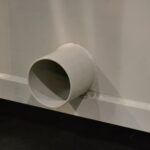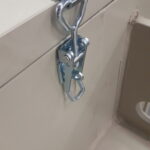With a heat exchanger exhaust air is used to warm up intake air, without mixing the air. The system contributes to a uniform distribution of intake air across the building. With a heat exchanger improved results are achieved and the use of energy is reduced upto 70%. The extra long plates in the exchanger enable these efficiencies. Buildings with heat exchangers also have better results in terms of growth, less medication, less fall-out and and improved living and working climate. The AIR2-DS also meets the Dutch BWL-standard for broilers farms.
Advantages of heat regaining
Less energy usage and lower costs of energy are important advantages of the AIR2-DS. The heat exchanger also contributes to a uniform climate, with an optimal temperature and humidity. Through this even distribution of air across the building, with a minimal draught, the animals are more evenly distributed across the entire room. The animals are calmer and animal stress is reduced. The growth results are better, there is less feed conversion and the use of medication is reduced. There is less fall-out and risk of disease decreases. Lastly, large differences in temperature, for example between day and night or during winter time are minimized too. It is possible to ventilate more during colder periods, thereby keeping the air quality optimal.
The AIR2-DS plate exchanger
The high efficiency heat exchanger with plates is produced completely from plastic. The housing is made from polypropylene sheets according to the ‘hollow chamber principle’. These are assembled air tight through extrusion welding. The plates and plate holders are produced completely from PVC and PE. Since the heat exchanger consists of plastic only, it is resistant to UV-radation and aggressive substances in the exhaust air. The system is completely corrosion free, a long lifespan is guaranteed.
The mechanism
The AIR2-DS heat exchanger from ITB is equipped with horizontally placed plates. The exhaust air is sucked past these plates with a high pressure fan, after which it is blown out through the exhaust chimney. The intake air is sucked through these same plates by a high pressure fan, and subsequently blown into the building. The thickness of the plates and the distance between the plates are calculated in such a way that maximum efficiency with minimum resistance are achieved.
Air distribution
Fresh intake air is blown towards the ridge of the house. At the first purline behind the ridge an ‘Air Catcher’ is placed. This is a perforated PVC sheet which lets through part of the air but catches most of it. Two recirculation fans, placed at either side of the Air Catcher and every next 20 meters, distribute the air through the building.
Cleaning and mainentance
The AIR2-DS is standard equipped with a spraynozzle system for cleaning during usage. The spraynozzles are activated in fases to minimize the effects on efficiency. Entry hatches at the side and top of the exchanger come standard. The system is easily accesible with a high pressure hose for additional cleaning, if needed. Plastic doors with a rubber airtight sealing enable acces to the control room of the heat exchanger.
Installation
Heat exchangers from ITB are easy to install. After placing the heat exchanger the air channels and water and electricity are connected.
Control
The AIR2-DS can be connected to control equipment of almost all suppliers. If required, control equipment can be included so the system can function ‘stand alone’.





